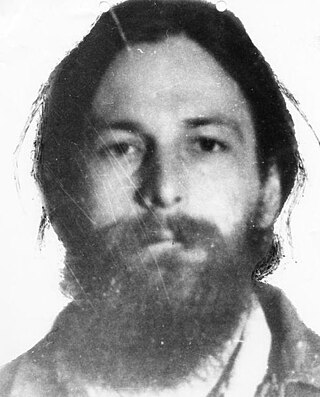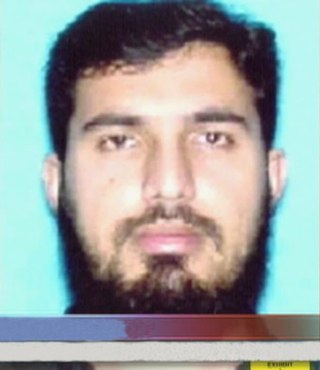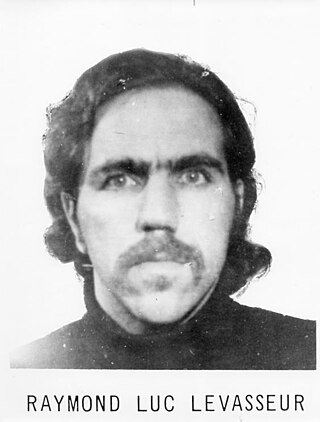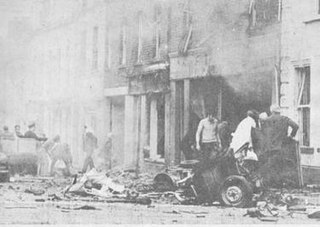Related Research Articles

Timothy James McVeigh was an American domestic terrorist who perpetrated the 1995 Oklahoma City bombing that killed 168 people, 19 of whom were children, injured 680, and destroyed one-third of the Alfred P. Murrah Federal Building. It remains the deadliest act of domestic terrorism in U.S. history.
The Fuerzas Armadas de Liberación Nacional was a Puerto Rican clandestine paramilitary organization that, through direct action, advocated independence for Puerto Rico. It carried out more than 130 bomb attacks in the United States between 1974 and 1983, including a 1975 bombing of the Fraunces Tavern in New York City that killed four people.

The Anarchist Cookbook, first published in 1971, is a book containing instructions for the manufacture of explosives, rudimentary telecommunications phreaking devices, and related weapons, as well as instructions for the home manufacture of illicit drugs, including LSD. It was written by William Powell at the apex of the counterculture era to protest against United States's involvement in the Vietnam War. Powell converted to Anglicanism in 1976 and later attempted to have the book removed from circulation. However, the copyright belonged to the publisher, who continued circulation until the company was acquired in 1991. Its legality has been questioned in several jurisdictions.

In the United States, a Joint Terrorism Task Forces (JTTF) is a locally-based multi-agency partnership between various federal, state, and local law enforcement agencies tasked with investigating terrorism and terrorism-related crimes, led by the Federal Bureau of Investigation and U.S. Department of Justice. The first JTTFs were established before the September 11 attacks, with their numbers increasing dramatically in the years after.
The May 19th Communist Organization was a US-based far-left armed terrorist group formed by members of the Weather Underground Organization. The group was originally known as the New York chapter of the Prairie Fire Organizing Committee (PFOC), an organization devoted to promoting the causes of the Weather Underground legally, as part of the Prairie Fire Manifesto's change in Weather Underground Organization strategy, which demanded both aboveground mass movements and clandestine organizations. The role of the clandestine organization would be to build the "consciousness of action" and prepare the way for the development of a people's militia. Concurrently, the role of the mass movement, the above-ground Prairie Fire Collective, would include the support for and the encouragement of armed action. Such an alliance would, according to Weather, "help create the 'sea' for the guerrillas to swim in." The M19CO name was derived from the birthdays of Ho Chi Minh and Malcolm X. The May 19 Communist Organization was active from 1978 to 1985. M19CO was a combination of the Black Liberation Army and the Weather Underground. It also included members of the Black Panthers, White Panthers, and the Republic of New Afrika (RNA).
In the United States, domestic terrorism is defined as terrorist acts that were carried out within the United States by U.S. citizens and/or U.S. permanent residents. As of 2021, the United States government considers white supremacists to be the top domestic terrorism threat.

Thomas William Manning was an American Marxist militant convicted of killing New Jersey State Police trooper Philip J. Lamonaco during a traffic stop in 1981. Before and after the murder he was involved with a Marxist organization, the United Freedom Front (UFF), which bombed a series of US military and commercial institutes and committed bank robberies in the 1970s and early 1980s.

Richard Wayne Snell was an American white supremacist convicted of killing two people, a black police officer and a pawn shop owner whom he mistook for a Jew, in Arkansas between November 3, 1983, and June 30, 1984. Snell was sentenced to death for one of the murders, and executed by lethal injection in 1995.
The Tyler poison gas plot was an American domestic terrorism plan in Tyler, Texas, thwarted in April 2003 with the arrest of three individuals and the seizure of a cyanide gas bomb along with a large arsenal. Authorities had been investigating the white supremacist conspirators for several years and the case received little media coverage and limited attention in public from the government.
Jaan Karl Laaman is an Estonia-born American criminal, convicted and imprisoned on various charges including a 1982 attempted murder of a police officer, and activist. He was a member of the United Freedom Front.

In the United States, a common definition of terrorism is the systematic or threatened use of violence in order to create a general climate of fear to intimidate a population or government and thereby effect political, religious, or ideological change. This article serves as a list and a compilation of acts of terrorism, attempts to commit acts of terrorism, and other such items which pertain to terrorist activities which are engaged in by non-state actors or spies who are acting in the interests of state actors or persons who are acting without the approval of foreign governments within the domestic borders of the United States.

The Animal Liberation Front (ALF) is an international, leaderless, decentralized political and social resistance movement that advocates and engages in what it calls non-violent direct action in protest against incidents of animal cruelty. It originated in the 1970s from the Bands of Mercy. Participants state it is a modern-day Underground Railroad, removing animals from laboratories and farms, destroying facilities, arranging safe houses, veterinary care and operating sanctuaries where the animals subsequently live. Critics have labelled them as eco-terrorists.

Najibullah Zazi is an Afghan-American who was arrested in September 2009 as part of the 2009 U.S. al Qaeda group accused of planning suicide bombings on the New York City Subway system, and who pleaded guilty as have two other defendants. U.S. prosecutors said Saleh al-Somali, al-Qaeda's head of external operations, and Rashid Rauf, an al-Qaeda operative, ordered the attack. Both were later killed in drone attacks.
Michael C. Finton, also known as Talib Islam, is an American convert to Islam and a part-time cook who attempted to bomb the Paul Findley Federal Building and the adjacent offices of Congressman Aaron Schock in downtown Springfield, Illinois, on 24 September 2009. He pleaded guilty in federal court on 9 May 2011 and was sentenced to 28 years in prison.

Raymond Luc "Ray" Levasseur is the former leader of the United Freedom Front, a militant Marxist organization that conducted a series of bombings and bank robberies throughout the United States from 1976 to 1984.

The Militia of Montana (MOM) is a paramilitary organization founded by David and John Trochmann of Noxon, Montana, United States. The organization formed from the remnants of the United Citizens for Justice in late 1992 in response to the standoff during the siege in Ruby Ridge, Idaho. The Militia of Montana reached their member high point in 1999 and largely disbanded after the Y2K threat turned out to be minor.

On 12 June 1973 the Provisional IRA detonated two carbombs in Coleraine, County Londonderry, Northern Ireland. The first bomb exploded at 3:00 pm on Railway Road, killing six people and injuring 33; several lost limbs and were left disabled for life. A second bomb exploded five minutes later at Hanover Place. This did not cause any injuries, although it added to the panic and confusion in the area. The IRA had sent a warning for the second bomb but said it had mistakenly given the wrong location for the first.
The Fort Smith sedition trial was a 1988 trial of fourteen white supremacists accused of plotting to overthrow the United States federal government and conspiring to assassinate federal officials. The fourteen defendants were acquitted after a two-month trial. One of the jurors later married one of the defendants, while another said they agreed with many of their views.
References
- ↑ Smith, Brent L. (1994). Terrorism in America : pipe bombs and pipe dreams. Albany: State University of New York Press. pp. 111–112. ISBN 0-585-06052-5. OCLC 42855404. Archived from the original on 2022-02-15. Retrieved 2022-02-15.
- 1 2 3 Phillip Jenkins. "Case-Study of US Domestic Terrorism: United Freedom Front". Archived from the original on 2012-08-05.
- 1 2 3 Bryan Burrough (2016). "23 - The Last Revolutionaries - The United Freedom Front, 1981 to 1984". Days Of Rage - America's Radical Underground, the FBI, and the Forgotten Age of Revolutionary Violence. Penguin Publishing Group. ISBN 9780143107972. Archived from the original on 2023-05-25.
- 1 2 3 4 Smith 110
- 1 2 Martin, Gus (2009). Understanding Terrorism: Challenges, Perspectives, and Issues (3 ed.). Sage. p. 433. ISBN 978-1-4129-7059-4. Archived from the original on 2021-09-02. Retrieved 2020-12-05.
- ↑ Smith 110, 112
- ↑ "Incident Summary for GTDID: 198403190012". www.start.umd.edu. Archived from the original on 2022-01-23. Retrieved 2022-02-15.
- ↑ Smith 111
- ↑ Ronald Kessler (November 9, 1983). "Group Hit Other Targets, FBI Believes" (PDF). Washington Post. Archived (PDF) from the original on 2023-05-25.
- 1 2 Prendergast, Alan (1995-07-12). "End of the Line". Denver News. p. 2. Archived from the original on 2010-11-18. Retrieved 2009-10-28.
- ↑ Nicas, Jack (12 November 2009). "UMass forum stirs painful memories for courthouse bomb victim". Boston Globe . Archived from the original on 11 January 2010. Retrieved 20 January 2010.
- 1 2 AP (1989-11-30). "Judge Declares Mistrial for 3 in Sedition Case". The New York Times. Archived from the original on 2011-09-20. Retrieved 2009-10-28.
- ↑ AP (1989-11-30). "Jury deadlocks in trial of radicals". Wilmington Daily Star. Retrieved 2009-10-28.[ dead link ]
- ↑ Gus 433
- ↑ "In Memoriam - 1980's - Trooper II Philip J. Lamonaco". State of New Jersey. Archived from the original on 2023-05-25.
- ↑ "United States v. Levasseur, 619 F. Supp. 775 (E.D.N.Y. 1985)". Justia Law. Archived from the original on 2020-12-04. Retrieved 2022-02-15.
- ↑ Paul Basken (1986). "Manning testified, claims self-defense". United Press International. Archived from the original on 2022-02-15. Retrieved 2022-02-15.
- 1 2 Matt Gray (2019-08-01). "Domestic terrorist convicted in murder of N.J. State Trooper Philip Lamonaco dies in prison". www.nj.com. Archived from the original on 2021-09-02. Retrieved 2021-09-04.
- 1 2 AP (1989-01-12). "After 9 Months of Delays, U.S. Tries 3 for Sedition". The New York Times. Archived from the original on 2011-09-20. Retrieved 2009-10-28.
- ↑ Churchill, Ward; Jim Vander wall (2002). The Cointelpro Papers : Documents from the FBI's Secret Wars Against Dissent in the United States. Cambridge, Mass.: South End Press. p. 316. ISBN 978-0-89608-648-7. Archived from the original on 2022-02-15. Retrieved 2020-12-05.
- 1 2 Smith 112
- ↑ 425
- ↑ United States of America, Plaintiff v. Raymond Luc LEVASSEUR, Jaan Karl Laaman, Thomas William Manning, Richard Charles Williams, Carol Ann Manning, Patricia Gros and Barbara Curzi, Defendants, 620F.Supp.624 (United States District Court, E.D. New York1985).
- ↑ Smith 112-13
- 1 2 3 Smith 113
- ↑ United States of America v. Ramond Levasseur, Carol Ann Manning, Thomas William Manning, Barbara Curzi-Laaman, Richard Charles Williams, Jaan Karl Laaman, 816F.2d37 (United States Court of Appeals, Second Circuit1987).
- ↑ Thomas W. Manning. "Tom Manning Short Biography". www.geocities.com. Archived from the original on 2009-10-27.
- 1 2 Berger, Dan (2005-12-14). "Two Prisoners Named Williams". The Nation . Archived from the original on 2015-07-13. Retrieved 2015-07-13.
- ↑ Stohl, Michael (1988). The Politics of Terrorism. CRC Press. p. 315. ISBN 978-0-8247-7814-9. Archived from the original on 2021-09-02. Retrieved 2020-12-05.
- ↑ Tomlinson, Gerard (1994). Murdered in Jersey. New Brunswick, N.J.: Rutgers University Press. p. 170. ISBN 978-0-8135-2078-0. Archived from the original on 2021-09-02. Retrieved 2020-12-05.
- ↑ Langum, David J. (September 1999). William M. Kunstler: the most hated lawyer in America. NYU Press. p. 261. ISBN 978-0-8147-5150-3. Archived from the original on 2021-09-02. Retrieved 2020-12-05.
- ↑ Berger, Dan (2008). "The Real Dragons: a Brief History of Political Militancy and Incarceration: 1960s to 2000s". In Matt Meyer (ed.). Let freedom ring : a collection of documents from the movements to free U.S. political prisoners. PM Press. p. 32. ISBN 978-1-60486-035-1. Archived from the original on 2021-09-02. Retrieved 2020-12-05.
- ↑ Acoli, Sundiata (2003). "An Updated History of the New Afrikan Prison Struggle". In Joy James (ed.). Imprisoned intellectuals : America's political prisoners write on life, liberation, and rebellion. Rowman & Littlefield. p. 153. ISBN 978-0-7425-2027-1. Archived from the original on 2021-09-02. Retrieved 2020-12-05.
- ↑ https://lpeproject.org/blog/rico-and-stop-cop-city-the-long-war-against-the-left/
- ↑ Lowry, Dick (1995-10-01), In the Line of Duty: Hunt for Justice (Crime, Thriller, Drama), Patchett Kaufman Entertainment, World International Network (WIN), archived from the original on 2020-11-12, retrieved 2022-02-15